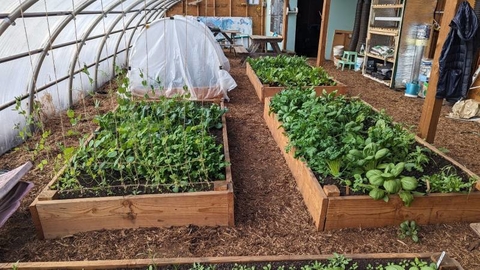Minnesota farmers have been key research and outreach partners with the University on deep winter greenhouse technology.
Minnesota’s cold and barren winters aren’t typically suited for traditional food production. However, thanks to deep winter greenhouse technology, farmers are starting to have more options and changing what is possible for winter food production in Minnesota.
A deep winter greenhouse (DWG) is a passive-solar greenhouse that relies on energy from the sun to heat the building instead of more traditional heating sources. The sun’s heat is captured and stored in a thermal mass that acts like a heat battery, storing heat during the daytime for release in the night when outside temperatures dip. Building on farmer innovation, the early research and development of this technology was spurred by the desire to reduce fossil fuel inputs in indoor food production.
In 2017 and 2018, a first-generation UMN-designed deep winter greenhouse was built in each of the five University of Minnesota Extension Regional Sustainable Development Partnerships (RSDP) regions. The locations were selected through an application process and used for research, food production and public education.
“These host sites taught us a lot about deep winter greenhouse production, marketing and design. It was from these sites that we learned that the footprint was too small and that the price tag was too high, ” explains Greg Schweser, RSDP statewide sustainable agriculture and food systems director. “So we went back to the drawing board.”
Schweser is part of a small but mighty deep winter greenhouse research team that started with Carol Ford, who with her late husband Chuck Waibel, was one of the first Minnesota farmers to build a deep winter greenhouse, and Daniel Handeen, a research fellow at the UMN Center for Sustainable Building Research. Through the years, Schweser, Ford and Handeen have been joined by researchers, Extension educators and students who have partnered with dozens of farmers, nonprofits, and other organizations to research, experiment and educate Minnesotans on deep winter greenhouses.
By early 2021, the team had a new design ready to test, now called a farm-scale deep winter greenhouse (FSDWG) because of its larger footprint. The team was also able to keep the construction costs in check for the new design, despite the increased size. Last year, the Minnesota legislature funded the Minnesota Department of Agriculture’s Agriculture Research, Education, Extension, and Technology Transfer (MDA AGREETT) program to support research, development and beta construction of five farm-scale deep winter greenhouses. The new award provides supplemental funding for selected farms to partner with the University to build an FSDWG, one in each of the five RSDP regions, and support monitoring, research and educational events.
“Like the first series of greenhouses, these new locations will be working production sites. They will host events, support research and, hopefully, inspire more farmers to plan and build a farm-scale deep winter greenhouse,” Schweser explains.
Minnesota farmers interested in deep winter greenhouse production are encouraged to explore the Deep Winter Greenhouses webpage. The page also includes the criteria and application form to be a farm-scale deep winter greenhouse partner. Applications are due on February 14.
Schweser is hopeful that final candidates will be selected by late spring and that the first greenhouse construction will break ground by late summer. If all goes as planned, he expects tours and programming to begin early in 2025.
“With farm-scale deep winter greenhouses, we hope to transform the small and medium-sized agricultural community and local food systems. Farmers will no longer be limited to the warm summer months for food production. With energy efficient greenhouses, farmers will be able to grow crops and generate revenue all year round, increasing their farm's viability and improving the healthy local food options for Minnesotans."


